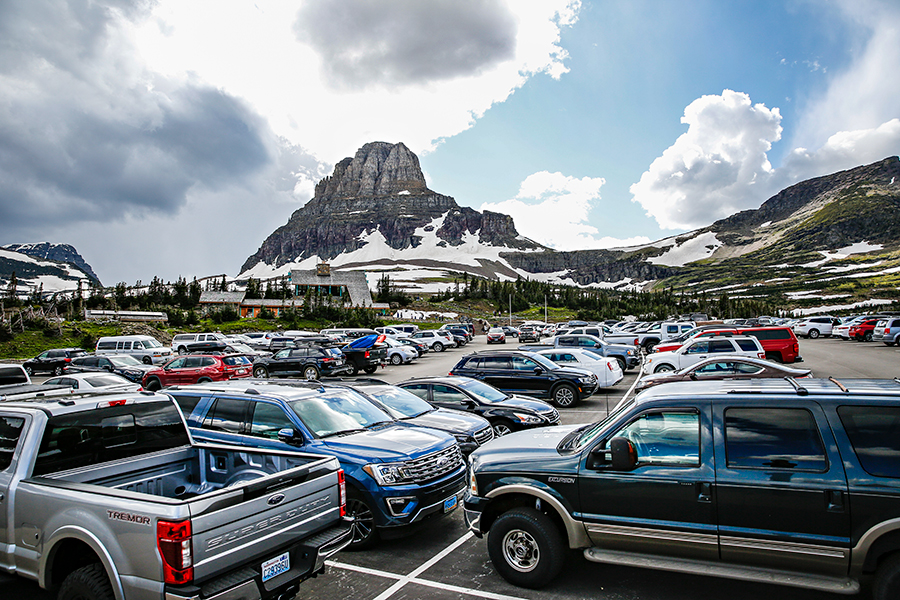After Labor Day Crush, Glacier National Park Prepares to Pare Back Operations for Fall
Visitation remains down even as congestion frustrates visitors and forces numerous temporary closures and restrictions
By Tristan Scott
The news that visitation to Glacier National Park was down 40% in August compared to previous years wasn’t surprising — after all, roughly half the park is closed due to COVID-19 restrictions — but the contrast between the numbers and the on-the-ground experiences of visitors encountering unprecedented congestion has never been starker.
Since entering its “summer like no other” — an apt and oft-used line to characterize the Glacier experience this summer in the age of coronavirus — park administrators have likened the business of managing the park’s 1 million acres of public land to building an airplane while flying. The unprecedented and unforeseen circumstances Glacier and other national parks have been dealt by the COVID-19 outbreak have demanded quick thinking, strong community engagement and a heavy emphasis on education.
Although challenges have persisted all summer, many of the wrinkles that emerged in May and June — when congestion peaked in the Lake McDonald and Apgar areas — were ironed out when the partial opening of Going-to-the-Sun Road allowed traffic flow up and over Logan Pass.
Before that, traffic jams forced road closures and restrictions at Apgar and Lake McDonald on a daily basis, but the opening of the Sun Road relieved that bottle-necking, even as nearly 2,000 vehicles entered through the West Glacier entrance on a daily basis.
In response to the COVID-19 outbreak, the Blackfeet Tribal Business Council on June 25 voted to keep roads on the park’s eastern boundary, which are on reservation land but allow access to the park, closed for the remainder of the visitor season. That meant the Going-to-the-Sun Road, Two Medicine and Many Glacier areas of the park could not be accessed from the east.
On July 13, when the park finally opened to vehicle traffic to Logan Pass on the west side, it marked the first time in the park’s history that the Going-to-the-Sun Road has been managed as a one-way in, one-way out vehicle access with a turnaround point at Rising Sun. While the opening allowed for 29 additional miles of roadway and nine additional trailheads for visitor access from the previous closure at Avalanche, it’s constrained a summer’s worth of visitation mostly to a single segment of the park.
Over Labor Day, visitation spiked again, and demand outstripped capacity at the park’s most popular locations, including Avalanche Campground and Logan Pass. When a winter storm swept over the Continental Divide on Sept. 7, blasting the Sun Road’s upper reaches with snow and ice, park officials decided to swing the gates at Avalanche for safety reasons and leave the closure in place through much of the day Sept. 8.
By 7 a.m. on Sept. 8, a line of vehicles was backed up at the Avalanche Creek closure, and by 9 a.m. the park had begun restricting inbound traffic at the foot of Lake McDonald.
The response from visitors wasn’t pretty.
“Are we able to get a refund on our pass?” one visitor posted on Twitter the day after Labor Day. “We were allowed to go to Lake McDonald yesterday and now can’t get back in. It’s sad that money is given for a pass and people cannot use them as the park is always closed.”
“This is crazy. Honestly can say I probably won’t come back to visit,” she wrote 20 minutes later.
According to park officials, the problems associated with the spike in visitation and the winter weather were compounded by a car crash that required emergency personnel to respond.
While Labor Day has typically marked the beginning of the end to summer’s busy cycle, park officials said it has become increasingly popular as visitors look to capitalize on the final weeks of summer.
Despite the recent surge in congestion, park officials have announced they will begin to adjust operating hours for visitor services including campgrounds, backcountry permits, boat inspections, and concession operations.
All front-country campgrounds are currently closed, with Fish Creek Campground closing as scheduled on Labor Day. One section of Apgar Campground (Loop B) will open for primitive camping starting Friday, Sept. 25, having been closed all summer. Campgrounds in primitive status have vault toilets available and fees are reduced. Potable water will be available in the campground through Oct. 6. No campground reservations will be issued, and all camping is first-come, first-served. For current campground status information, visit the park’s campground status page.
Backcountry camping by permit remains available to visitors. The Apgar Backcountry Permit Office is open 8 a.m. to 4 p.m. through Oct. 31. Backcountry permits will be issued until 30 minutes prior to closing. No reservations for backcountry permits are available. All permits are issued in-person, up to 24 hours in advance.
Lake McDonald remains the only body of water open to watercraft in the park. Boat inspection station hours are currently 9 a.m. to 7 p.m., seven days a week. Inspection hours will change to 8 a.m. to 4 p.m. starting Sept. 27.
Visitor information services at Logan Pass Visitor Center continue daily through Sunday, Sept. 27. The Glacier National Park Conservancy bookstore operating at Logan Pass Visitor Center will close Sept. 27, but potable water is no longer available at the pass.
Visitor information services at Apgar Visitor Center will continue daily through Oct. 4, and then move to weekends only through the end of October, weather permitting. Restrooms and potable water are available at the Apgar Visitor Center plaza year-round.
The Going-to-the-Sun Road is scheduled to close at Avalanche Creek starting Oct. 19, weather permitting. The section of the road between Rising Sun and St. Mary remains closed due to COVID-19 operating requirements.